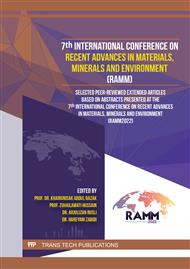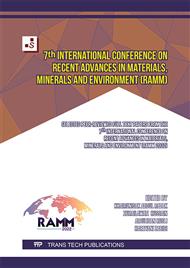[1]
M. B. Aicha, "The superplasticizer effect on the rheological and mechanical properties of self-compacting concrete," in New Materials in Civil Engineering, Elsevier Inc. , 2020, pp.315-331.
DOI: 10.1016/b978-0-12-818961-0.00008-9
Google Scholar
[2]
Y. Xu, M. Hu, D. Chen, Z. Liu, Y. Yu, H. Zhang and J. Guo, "Performance and working mechanism of amphoteric polycarboxylate-based dispersant and sulfonated acetone formaldehyde polycondensate-based dispersant in oil well cement," Construction and Building Materials , vol. 233, no. 117147, 2020.
DOI: 10.1016/j.conbuildmat.2019.117147
Google Scholar
[3]
Y. Xu, M. Liu, P. Li, L. Zhu, X. Xia, C. Zhang, Y. Yu and J. Guo, "Effect of dispersant types on the rheological and mechanical properties of oil well cement paste with nanosilica," Construction and Building Materials, vol. 271, no. 121576, 2021.
DOI: 10.1016/j.conbuildmat.2020.121576
Google Scholar
[4]
X. Xia, Y. Yu, J. Jin, S. Liu, M. Xu and Z. Zhang, "Performance Evaluation of Polycarboxylic Acid Dispersant for Oil Well Cementing," Materials Science Forum, vol. 993, pp.1341-1350, 2019.
DOI: 10.4028/www.scientific.net/msf.993.1341
Google Scholar
[5]
W. Zhai, C. Wang, X. Yao, D. Dai, L. Wang, C. Geng, X. Wu and S. Hua, "Characteristics of polycarboxylate-based dispersant suitable for medium and low temperature oil well cementing," Construction and Building Materials , vol. 290, no. 123239, 2021.
DOI: 10.1016/j.conbuildmat.2021.123239
Google Scholar
[6]
D. Kanesan, S. Ridha and P. Rao, "Formulation of geopolymer cement using mixture of slag and class f fly ash for oil well cementing," in 7th International Conference on Key Engineering Materials (ICKEM 2017), Penang, 2017.
DOI: 10.1088/1757-899x/201/1/012014
Google Scholar
[7]
G. Zhang and J. Lu, "Experimental research on the mechanical properties of graphene geopolymer," AIP ADVANCES , vol. 8, no. 065209, pp.1-10, 2018.
Google Scholar
[8]
A. P. Institute, "ANSI/API RECOMMENDED PRACTICE 10B-2," API Publishing Services, Washington, 2010.
Google Scholar
[9]
M. S. Mohammed, S. A. Mohamed and M. A. M. Johari, "Influence of Superplasticizer Compatibility on the Setting Time, Strength and Stiffening Characteristics of Concrete," Advances in Applied Sciences , vol. 1, no. 2, pp.30-36, 2016.
Google Scholar
[10]
L. Yang, E. Yilmaz, J. Li, H. Liu and H. Jiang, "Effect of superplasticizer type and dosage on fluidity and strength behavior of cemented tailings backfill with different solid contents," Construction and Building Materials, vol. 187, pp.290-298, 2018.
DOI: 10.1016/j.conbuildmat.2018.07.155
Google Scholar
[11]
T. P. Wigestika and J. J. Ekaputri, "Addition of Superplasticizer on Geopolymer Concrete," APRN Journal of Engineering and Applied Sciences, vol. 11, no. 24, pp.14456-14462, 2016.
Google Scholar
[12]
P. R. Vora and U. V. Dave, "Parametric Studies on Compressive Strength of Geopolymer Concrete," in Chemical, Civil and Mechanical Engineering Tracks of 3rd Nirma University International conference on Engineering (NUiCONE-2012), Ahmedabad, 2013.
DOI: 10.1016/j.proeng.2013.01.030
Google Scholar
[13]
F. A. Memon, M. F. Nuruddin, S. Demie and N. Shafiq, "Effect of Superplasticizer and Extra Water on Workability and Compressive Strength of Self-Compacting Geopolymer Concrete," Research Journal of Applied Sciences, Engineering and Technology , vol. 4, no. 5, pp.407-414, 2012.
DOI: 10.1109/natpc.2011.6136362
Google Scholar
[14]
S. Alsadey, "Effect of Superplasticizer on Fresh and Hardened Properties of Concrete," Journal of Agricultural Science and Engineering, vol. 1, no. 2, pp.70-74, 2015.
Google Scholar
[15]
E. B. Nelson and D. Guillot, Well Cementing, Texas: Schlumberger, 2006.
Google Scholar
[16]
Y. Xu, M. Liu, P. Li, L. Zhu, X. Xia, C. Zhang, Y. Yu and J. Guo, "Effect of dispersant types on the rheological and mechanical properties of oil well cement paste with nanosilica," Construction and Building Materials, vol. 271, pp.121576-121583, 2021.
DOI: 10.1016/j.conbuildmat.2020.121576
Google Scholar
[17]
E. B. Nelson and D. Guillot, Well Cementing, Texas: Schlumberger , 2006.
Google Scholar



